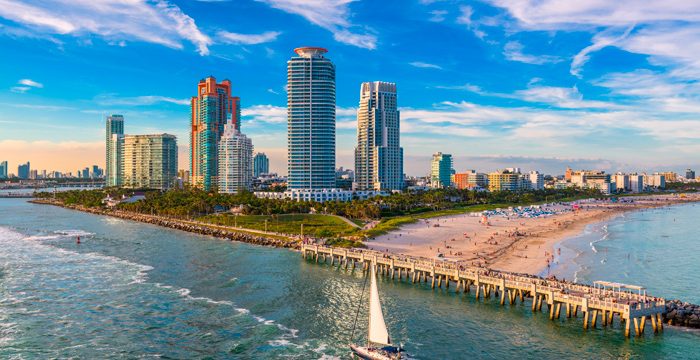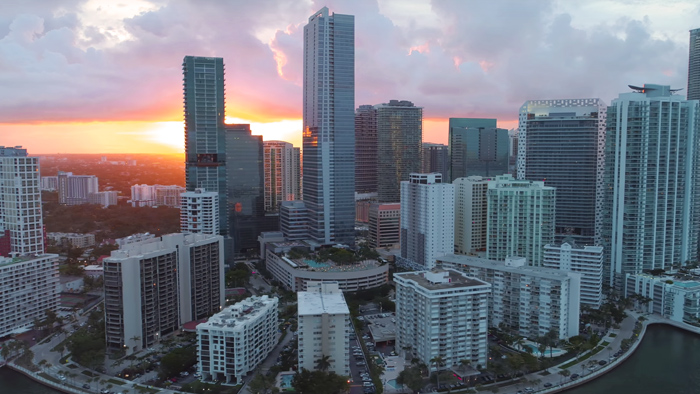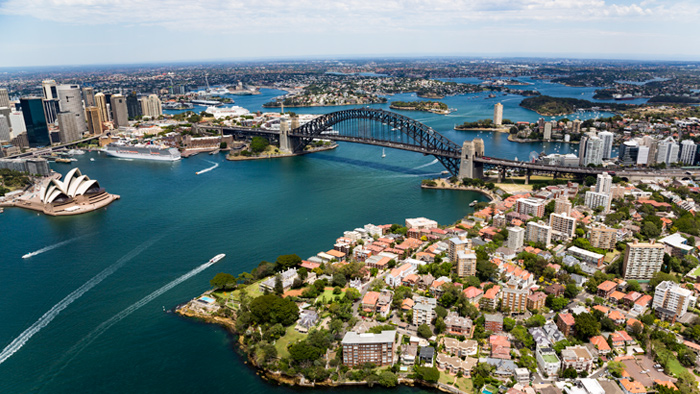What is the Miami Sea Level Rise Plan?

The question arises in connection with the calls made about sea level rise and the alarms that ignite every time a hurricane passes near its shores. The floods and devastation that climate change is causing worldwide, are not so far from Miami.
The effects of climate change are beginning to worry investors and Miami authorities because of the city’s location. Despite being surrounded by water, Miami has been one of the cities least affected by the sea, because it has been kept for decades out of reach.
Its future as a center of business, tourism, art and culture depends on how safe the city is for the tens of thousands of people it shelters permanently or temporarily and for its properties in the coming years.
Fortunately, a movement is underway, whose main objective is to adapt the city to the new threats projected by scientists for about 30 years, when the greenhouse effect of climate change increases the temperature by 2 or 3 degrees. That is, it seeks to coexist with these threats, but prevent them from affecting their residents.
Prevention measures taken by the city of Miami.
In a referendum held in 2017, citizens of Miami voted to approve new taxes for the construction and development of resilience projects to cope with floods and storms, through the issuance of bonds worth 400 million dollars.
Miami. is an extensive coastal city that seems very dry, planted with buildings, roads and green areas, but when seen from the air, it can be noticed that it is just a tongue of land surrounded by a vast ocean and crossed by canals and lakes, from Biscayne Bay to the Everglades.
Miami-Dade County rises above the Biscayne Aquifer, consisting of 4,000 square miles of porous limestone that is shallow. These stones are formed by small air pockets that fill with rainwater and the rivers that extend from the swamp to the ocean.
This prevents the city from flooding. The aquifer and the water consumption of the city itself, are responsible for absorbing this large water volume, preventing it from reaching the city. If Miami. did not have such particular conditions, it would become a very hot and inhospitable desert.
What is the city doing?
During the passing of Hurricane Irma in 2017, a stretch of buildings on Brickell Bay Drive, were greatly affected by this violent natural phenomenon. The damage caused by the hurricane exposed the vulnerability of Miami to an increase in sea level that, according to scientific studies, could rise from one to two feet in 2060.
The local government administration is thinking of an ambitious project to redesign the coast to give it greater security. It is likely that native plants will be used to absorb water and dykes to contain their strength, in order to protect the properties of this exclusive sector of the city. The authorities are convinced of the effectiveness of the plan and even believe that this technology could be exported to other parts of the world.
Recently, Miami Mayor Francis Suarez, who is a member of the Global Commission for Adaptation, the former Secretary General of the United Nations, Ban Ki-moon who heads it, and Patrick Verkooijen, executive director of the commission, toured several sites in Miami., where these projects of resilience have already been financed by sea level rise and other areas at risk.
This commission that also integrates Bill Gates and the Executive Director of the World Bank, Kristalina Georgieva, is propping up the city of Miami as an example of how profitable investments are in the communities to protect them against climate change.
The city has also invested in the installation of a series of pumping stations to suck millions of gallons of water daily. These waters are transferred to the Miami River that crosses the city and bay. Of the 300 water outlets that the city has, approximately 50 are vulnerable to the change to increases in water levels.
Although in reality a good part of the city is vulnerable to an increase in sea level, there are some areas that are more vulnerable than others. There is a lot to lose in residential infrastructure and services.
Expensive existing real estate and all projects that are yet to be built, require quick and appropriate decisions to mitigate the damage that climate changes may cause.
As Ban Ki-moon himself warns, by the end of the century the planet could warm up by about 3 degrees. This would mean the end for Miami. Even with just 2 degrees of temperature increase the danger would be imminent. So there is an “existential threat” that must be addressed with concrete and sufficient actions immediately.
What is being done in other cities of the world?
Amsterdam is a global example of adaptation and fight against climate change. The experience of the Dutch capital on the management of its water resources to gain space to the sea, is one of its best contributions to the world along with the incorporation of norms and projects of ecological and self-sustainable infrastructure to avoid the increase of environmental pollution.
The city has the most sophisticated dam and water management system in the world. But now the challenge is to convert this city of 600 thousand inhabitants, a world reference on methods of protection of sea level rise, as well as floods due to rain and the treatment of periods of drought.
In addition, in Amsterdam, the first free plastic supermarket was recently inaugurated, a clear example of the city’s commitment to a paradigm shift to achieve a more ecological and natural world.
Other cities located in coastal areas or with large rivers and heavy rains that are seriously undertaking plans to protect the population from the effects of climate change are: Los Angeles, New York, Houston, Boston and New Orleans in the United States as well as London, Glasgow, Istanbul, Hamburg and Lisbon, but lesser extent.
In Asia, major damage is also expected in the Chinese cities of Shanghai, Canton, Shenzen, Tianjin, Xiamen and Zhanjiang, if urgent measures are not taken to prevent or mitigate floods due to climate change.
Cities that have taken action against climate change
Several cities around the world are developing specific projects to face climate change. Here we present some very clear examples of their commitment to preserving the environment and reducing the impact of global warming.
Curitiba (Brasil)
It is one of the best organized cities in the world and is focusing its efforts towards the creation of sustainable communities. Curitiba seeks to achieve a substantial reduction of emissions that cause the greenhouse effect, through the development of urban agriculture.
Directly, through the capture of carbon dioxide from the earth, in addition to the biological fixation of nitrogen with crops of legumes and avoid the use of chemical nitrogen fertilizers.
Indirectly, it is avoiding gas emissions by reducing distances in the transport of food and waste: also through the composting of organic waste, a substantial reduction of the so-called “heat islands” and by means of public interest campaigns to create ecological awareness
Sydney and Melbourne (Australia)
The environmental program of these two Australian cities called CitySwitch Green Office, is based on the creation of energy efficiency. This initiative seeks to overcome the lack of knowledge and resources that exists between real estate owners and tenants, so the report of auditable achievements is prioritized and the population is encouraged to adopt a high energy objective.
The general objective of the program is to avoid the emission of 50,000 tons of CO2 per year by the subscribing companies.
Paris (France)
The city of light works on a program of evaluations and adaptation plans, called the Paris Adaptation Strategy. This program aims to address the challenge of climate change and its consequences: floods, heat waves, droughts and the urban heat island effect.
In the same way, the program covers other problems related to sustainability such as air pollution and its consequences for health, as well as the challenges that refugees face as a result of climate and water scarcity.
Among the actions that are being implemented, specifically are the reduction of risks linked to heat through an ecological program; the supply of food to the most vulnerable populations and assistance to citizens during the hottest seasons.
Kolkata (India)
Solid waste is a problem that Calcutta is dealing with in a responsible and ecological way. The increase of garbage dumps in the city, became a problem and through the Solid Waste Management Improvement Project, the population is being taught to separate the waste from the home to the transfer stations.
Advances to reach the goal vary according to the city sector between 60 and 80%. Subsequently, the project seeks to eradicate once and for all open land dumps and the burning of garbage. Also, limit the dangerous concentration of methane gas that is generated in landfills.
Other cities in the world that are developing similar programs are: Seoul with its Social Equity and Climate Change Program; Portland through the Climate Action Plans and inventories, Shenzhen with Financial and Economic Development and Yokohama through the Clean Energy Program.
As seen throughout the world, the largest cities vulnerable to climate change, are taking initiatives to adapt to their effects and to preserve the environment to progressively decontaminate the planet. Invest in protection and adaptation projects, well worth it!
If you want to invest in real estate in Miami, contact our real estate team, Miami Residential Group Inc, we can help answer all your questions about the most profitable and safest condominiums in the city.

 EN
EN ES
ES PT
PT




